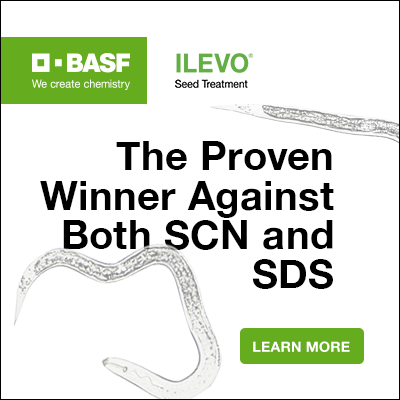ILEVO® Seed Treatment
ILEVO® seed treatment is the trusted, proven winner in protecting against two of the biggest threats to your soybean crop: soybean cyst nematodes (SCN) and sudden death syndrome (SDS).
SCN is the leading yield robber in soybeans and is estimated to impact more than $1.5b in yield losses annually.1 Fields with SCN often also struggle with SDS, leading to compounded yield losses. While SCN causes the most damage in hot, dry conditions and SDS thrives in cool, wet conditions, it is critical to manage both pests together to protect your yield and profit potential.
Stop SCN and SDS and optimize yield potential with the solution trusted by farmers to protect over 75 million acres from both pests for the past decade. ILEVO seed treatment delivers powerful, proven performance against both SDS and SCN, year after year.
Track SCN Levels in Your State
SCN is a widespread pest threatening soybean yield potential across the Midwest — causing an average 5.4 bu/A average yield loss annually.6 See the sampling results in your state.
How Much are Soybean Cyst Nematodes Robbing from You?
Widespread and unseen, SCN can cause over $50,000 loss in revenue per 1,000 A/year5* — and you likely won’t see the symptoms until it’s too late. Find out how much is at stake with the SCN Profit Checker below.
*Estimated revenue loss for 1,000 acre soybean farmer with commodity prices of $10.00/bu.
Soybean Farmers Win with ILEVO Seed Treatment
We asked, and farmers answered. Here’s why farmers trust ILEVO seed treatment as the proven winner to protect against SCN and SDS on their acres, year after year.
“With the goal of planting beans as early as we can every year. We have continually seen the benefits of ILEVO seed treatment with better SDS & SCN control.” – Soybean farmer, IL
“We experience very little sudden death in our fields by using ILEVO seed treatment, while surrounding field have large areas of sudden death.” – Soybean farmer, IA

Videos
SCN Action Month: The Double Threat
Management Starts with Soil Sampling
Downstream Seed Treating Application Basics

Connect with your local rep
Enter Zip Code or City
Key Pests
Identifying SDS
There are many symptoms you may notice in your soybean plants that will help you identify SDS in your fields.
- Sudden Death Syndrome (caused by Fusarium virguliforme)
- Septoria Brown Spot (early season) (Septoria glycines)
- Soilborne nematodes: Lance nematodes (Hoplolaimus spp.)
- Reinform nematode (Rotylenchulus reinformis)
- Root-knot nematode (Meloidogyne incognita)
- Root lesion nematode (Pratylenchus spp.)
See 'Labels and MSDS' below for special or state-labeled pests.
1Crop Protection Network, Annual Disease Loss Estimates. 2023.
2Company Sponsored Research. 2011-2024.>350 Trials under varying levels of SDS and/or Nematode Pressure. Yield comparison to F+I base2.
3BASF Greenhouse Trials.
4Company sponsored university trials (n=3) conducted in Illinois and Kentucky. Season-long disease pressure was evaluated by rating the incidence and severity of foliar symptoms compared to F+I base3. For suppression of red crown rot (Calonectria ilicicola) in soybeans in the following states Arkansas, Illinois, Indiana, Iowa, Kentucky, Michigan, Minnesota, Missouri, Ohio, Tennessee, and Wisconsin when applied at 0.25 mg ai/seed (1.97 fl oz/140,000 seeds).
5Crop Protection Network, Using ILEVO with preemergence herbicides, 2025
6SCN Coalition grower survey, 2024.
Always read and follow label directions. ILEVO is a registered trademark of BASF. All other trademarks are the property of their respective owners and use of any such trademark does not imply any affiliation with or endorsement by its owner. © 2025 BASF Agricultural Solutions US LLC. All rights reserved.


